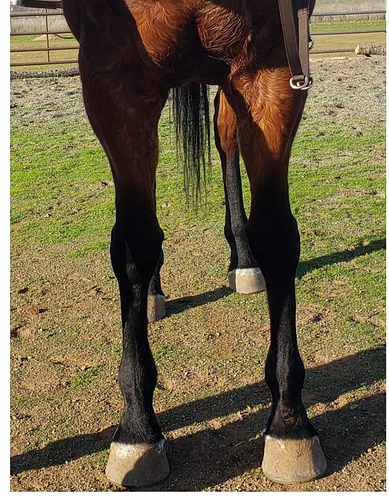It depends (LOL). On just how severe the issue with the knees is, and on luck. I’ve seen horses with offset knees (“bench knees”) stay sound in hard work, as long as any other horse does. I’ve seen horses with “perfect” leg conformation be unsound in light work. If it “bugs” you to look at those knees every day, then perhaps the horse is not for you. But if you can look past the knees and appreciate the rest of the horse, it’s a risk that only you can decide if it is right for you.
I’d take a chance on “offset” or “bench” knees before taking one that is “crooked through the knee”, bowlegged or knock kneed. With offset knees, the joint is unevenly weighted, but the weight is still vertical. With crooked knees, more angle through the joint makes it worse for future soundness, development of arthritic changes in the knee joint. You will often get a splint under the bench knee… this is just from the uneven loading on the joint heating up the ligaments that connect the splint bone to the cannon bone, and once that connection is solidly fused, it is much stronger in the support of the joint above it. All splint bones will fuse to cannon bones in this manner eventually, usually without forming an actual “splint”, the bench kneed conformation just accelerates the process. Once fused, the knee above is better supported, with either straight or bench kneed conformation. Splints that may or may not form in the process will often reduce in size with time, and are usually “cosmetic” issues only, once set and cool.
So, as always, you pay your money and take your chances, as with any horse you buy. If you can’t stop thinking about her, maybe it’s time to act on your intuition. As with any and every horse, being correctly trimmed and shod will drastically effect future soundness. With a straight legged horse, it’s easier to see what is “level”. With a horse with “deviations”, the foot still has to land flat, otherwise joints above will be damaged. What is “flat” with a crooked legged horse doesn’t look as pretty as it does with a horse who is actually conformed “straight” legged. A good farrier knows this, a poor one often doesn’t. Farriers trying to make crooked legged horses “look straight” is often the basis for future unsoundness in crooked legged horses.
I saw a TB yearling at the local yearling sale many years ago now. She had a set of legs that should have been in a text book under “horrific”, and a lovely set of lop ears. Offset knees, and toe in (which often go together). She was sold as a racing prospect, which I remember amazed me at the time. She never raced, and was going to be sold for meat as a 2 yr old, I heard. But someone bought her as a show horse prospect instead, and she turned up at the shows a few years later, in the green hunter classes. She did well, very successful, she jumped beautifully, won championships, . A few years after that, she moved into the jumper classes, and progressed on into the Grand Prix jumper classes in the following years, where I had to compete against her. When I last saw her, she was 22 years old, and had melanomas (she was grey), and still jumping around in the biggest jumper divisions. She was a star, very nice horse. This was in the days BEFORE regular and repeated joint injections were the norm for all horses, and in the days that all riders who didn’t make “minimum weight” naturally had to carry leaded weight pads to make 165 pounds in the Open Jumper divisions. Someone took the chance on her, and it paid off.
 )
)
